After a stunning 2021 Olympic debut, indoor rock climbing is having a moment. And for good reason: It’s an incredible way to build strength, a great stepping-stone to outdoor rock climbing, and the most fun you’ll ever have inside on a rainy day. And for many climbers, it’s also a lifelong passion and a valuable source of community.
Yet, despite the Olympic hype and amazing benefits, it can still be really intimidating to step into a rock climbing gym for the first time. Fortunately, the climbing community is famous for being laid-back and welcoming, and climbing gyms are great places to learn new skills in a supportive environment. That said, it helps to have an understanding of the basics before you head in for your first visit. In this guide, we’ll cover everything you need to know to step into the gym with confidence.
- How To Find a Rock Climbing Gym
- Types of Indoor Rock Climbing
- When To Go
- Essential Gear
- What Do the Grades Mean?
- Beginner Tips for Indoor Rock Climbing
- The Fine Print: Gym Etiquette
How To Find a Rock Climbing Gym
Finding a local climbing gym is usually as easy as a quick internet search. Make sure the gym offers the type of climbing you hope to pursue, whether that’s bouldering, top roping, or leading (not all gyms offer all three). Climbing solo? Ask if the gym has auto-belays, which are devices that allow you to climb on a rope without a partner. Also be sure to compare prices and offerings. Some rock climbing gyms offer yoga classes and/or weightlifting equipment—and upcharge accordingly.
Types of Indoor Rock Climbing
There are a few different disciplines of indoor rock climbing. You can pick one to specialize in, but many climbers dabble in all three.
Bouldering
Climbing near the ground without ropes. Bouldering usually prioritizes strength, power, and problem-solving ability over endurance. It’s the most social discipline of climbing.
Top Roping
Climbing with a rope attached at an anchor above you so that you can sit back into your harness if you need a break without losing progress. Top roping is a great way to build strength and endurance without much risk.
Leading
Climbing from the ground up, clipping a rope into fixed anchor points on the wall as you go. Lead climbing requires a bit more gear and a steeper learning curve, but it most closely simulates climbing outdoors.
When to Go
Crowded gyms can be a little overwhelming, especially when you’re new and you’re trying to get your bearings. Many gyms experience a rush hour between 4 and 8 p.m., on weekdays, and those that offer kids’ camps and birthday parties are often busy on weekend afternoons. Try visiting the gym on a weekend evening, a morning before work, or during your lunch break.
Indoor Rock Climbing Gear Checklist
You can rent all the gear you’ll need at the gym. But if you’re buying your own stuff, here’s a complete gear checklist for indoor rock climbing.
- Climbing pants, joggers, or leggings
- A breathable T-shirt or tank top
- Sweater or long-sleeve shirt if you get chilly belaying
- Harness
- Climbing shoes
- Belay device
- Locking carabiner
- Chalk bag
- Chalk
- Optional: 40-meter rope (required for lead climbing in some gyms)
- Optional: Chalk ball or liquid chalk (required in some gyms)
- Optional: Belay glasses
- Optional: Belay gloves






